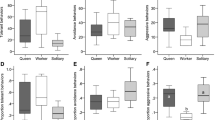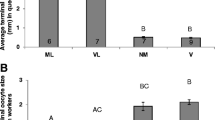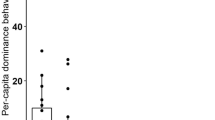Abstract
The establishment of reproductive division of labor in primitively eusocial insects is typically based on dominance interactions from the queen toward her worker daughters. We used a standardized behavioral assay, the circle tube, to observe aggressive and other behaviors between the queen and workers of field-collected social colonies of the sweat bee, Megalopta genalis. Queens generally expressed higher levels of aggressive and dominant behaviors than workers. Workers performed two behaviors, ‘C-posture’ and ‘reverse’, more frequently than queens. Our data suggest a defensive function for C-posture in workers, as it correlated with the expression of queen aggression. Within queens, the aggressive behaviors ‘nudge’, ‘bite’, ‘push’, and ‘chase’ correlated with each other in their frequencies of expression; the other two behaviors that were performed more often by queens (‘back up’ and ‘back into’) did not. The two behaviors performed more often by workers, ‘C-posture’ and ‘reverse’, were not correlated in workers. Queen and worker activity levels were correlated. Body size correlated with increased expression of queen-like behavior in both the queen and worker castes. Queens generally were bigger and had larger ovaries than workers. Queen–worker body size and ovary size differences correlated with behavioral differences. The effects of body size suggest an influence of developmental nutrition on adult behavior.





Similar content being viewed by others
References
Arneson L, Wcislo WT (2003) Dominant-subordinate relationships in a facultatively social, nocturnal bee, Megalopta genalis (Hymenoptera: Halictidae). J Kans Entomol Soc 76:183–193
Awde D, Richards M (2018) Investigating queen influence on worker behaviour using comparisons of queenless and queenright workers. Insectes Soc 65:1–13
Baier A, Wittek B, Brembs B (2002) Drosophila as a new model organism for the neurobiology of aggression? J Exp Biol 205:1233–1240
Barron AB, Maleszka J, Vander Meer RK, Robinson GE, Maleszka R (2007) Comparing injection, feeding and topical application methods for treatment of honeybees with octopamine. J Insect Physiol 53:187–194
Bloch G, Simon T, Robinson G, Hefetz A (2000) Brain biogenic amines and reproductive dominance in bumble bees (Bombus terrestris). J Comp Physiol A 186:261–268
Bourke A (1999) Colony size, social complexity and reproductive conflict in social insects. J Evol Biol 12:245–257
Bourke AF (2011) Principles of social evolution. Oxford University Press, Oxford
Breed MD, Gamboa GJ (1977) Behavioral control of workers by queens in primitively eusocial bees. Science 195:694–696
Breed MD, Silverman JM, Bell WJ (1978) Agonistic behavior, social interactions, and behavioral specialization in a primitively eusocial bee. Insectes Soc 25:351–364
Buckle G (1982) Differentiation of queens and nestmate interactions of newly established colonies of Lasioglossum zephyrum (Hymenoptera: Halictidae). Sociobiology 7:8–20
Conover W (1999) Practical nonparametric statistics. Wiley, Hoboken
Cuvillier-Hot V, Lenoir A (2006) Biogenic amine levels, reproduction and social dominance in the queenless ant Streblognathus peetersi. Naturwissenschaften 93:149–153
Dalmazzo M, Roig-Alsina A (2015) Social biology of Augochlora (Augochlora) phoemonoe (Hymenoptera, Halictidae) reared in laboratory nests. Insectes Soc 62:315–323
Dalmazzo M, Roig-Alsina A (2018a) Dominant-subordinate social interactions and subordinate behavioral responses in the primitively eusocial sweat bee Augochlora phoemonoe (Hymenoptera: Halictidae). Apidologie 49:852–861
Dalmazzo M, Roig-Alsina A (2018b) Primitively eusocial behavior observed in colonies of Augochlora amphitrite (Hymenoptera: Halictidae) reared in laboratory. Sociobiology 65:773–776
Dew RM, Gardner MG, Schwarz MP (2014) The problems of a priori categorisation of agonism and cooperation: circle-tube interactions in two allodapine bees. Ethology 120:551–562
Gonzalez V, Patton R, Plascencia M, Girigin A, Çakmak I, Barthell J (2018) High levels of tolerance between nestmates and non-nestmates in the primitively eusocial sweat bee Halictus scabiosae (Rossi) in Turkey (Hymenoptera: Halictidae). Insectes Soc 65:339–343
Hamilton AR, Shpigler H, Bloch G, Wheeler DE, Robinson GE (2017) Endocrine influences on the organization of insect societies. In: Pfaff DW, Joëls M (eds) Hormones, Brain and Behavior, 3rd edn. Academic Press, Oxford, pp 421–452
Hoyer SC, Eckart A, Herrel A, Zars T, Fischer SA, Hardie SL, Heisenberg M (2008) Octopamine in male aggression of Drosophila. Curr Biol 18:159–167
Jeanne R (2003) Social complexity in the Hymenoptera, with special attention to the wasps. In: Kikuchi T, Azuma N, Higashi S (eds) Proceedings of the 14th congress of the IUSSI. Hokkaido University Press, Sapporo, pp 81–130
Kamhi JF, Arganda S, Moreau CS, Traniello JF (2017) Origins of aminergic regulation of behavior in complex insect social systems. Front Syst Neurosci 11:74
Kapheim KM (2017) Nutritional, endocrine, and social influences on reproductive physiology at the origins of social behavior. Curr Opin Insect Sci 22:62–70
Kapheim KM, Bernal SP, Smith AR, Nonacs P, Wcislo WT (2011) Support for maternal manipulation of developmental nutrition in a facultatively eusocial bee, Megalopta genalis (Halictidae). Behav Ecol Sociobiol 65:1179–1190
Kapheim KM, Smith AR, Ihle KE, Amdam GV, Nonacs P, Wcislo WT (2012) Physiological variation as a mechanism for developmental caste-biasing in a facultatively eusocial sweat bee. Proc Biol Sci 279:1437–1446. https://doi.org/10.1098/rspb.2011.1652
Kapheim KM, Smith AR, Nonacs P, Wcislo WT, Wayne RK (2013) Foundress polyphenism and the origins of eusociality in a facultatively eusocial sweat bee, Megalopta genalis (Halictidae). Behav Ecol Sociobiol 67:331–340
Kapheim KM, Chan T, Smith A, Wcislo WT, Nonacs P (2016) Ontogeny of division of labor in a facultatively eusocial sweat bee Megalopta genalis. Insectes Soc 63:185–191
Kelber A, Warrant EJ, Pfaff M, Wallén R, Theobald JC, Wcislo WT, Raguso RA (2006) Light intensity limits foraging activity in nocturnal and crepuscular bees. Behav Ecol 17:63–72
Kocher SD, Paxton RJ (2014) Comparative methods offer powerful insights into social evolution in bees. Apidologie 45:289–305
Kukuk PF (1992) Social interactions and familiarity in a communal halictine bee Lasioglossum (Chilalictus) hemichalceum. Ethology 91:291–300
Lawson SP, Helmreich SL, Rehan SM (2017) Effects of nutritional deprivation on development and behavior in the subsocial bee Ceratina calcarata (Hymenoptera: Xylocopinae). J Exp Biol 220:4456–4462. https://doi.org/10.1242/jeb.160531
Leigh EG (1999) Tropical forest ecology: a view from Barro Colorado Island. Oxford University Press, Oxford
McConnell-Garner J, Kukuk PF (1997) Behavioral interactions of two solitary, halictine bees with comparisons among solitary, communal and eusocial species. Ethology 103:19–32
Michener CD (1974) The social behavior of the bees: a comparative study. Harvard University Press, Cambridge, MA
Michener CD (1990) Reproduction and castes in social halictine bees. In: Engels W (ed) Social Insects. Springer, Berlin, pp 77–121
Michener C, Brothers D (1974) Were workers of eusocial hymenoptera initially altruistic or oppressed. Proc Natl Acad Sci USA 71:671–674. https://doi.org/10.1073/pnas.71.3.671
Mueller UG (1991) Haplodiploidy and the evolution of facultative sex ratios in a primitively eusocial bee. Science 254:442–444 (254/5030/442 [pii])
Neckameyer WS, Leal SM (2017) Diverse functions of insect biogenic amines as neurotransmitters, neuromodulators, and neurohormones. In: Pfaff DW, Joëls M (eds) Hormones, brain and behavior, 3rd edn. Adademic Press, Oxford, pp 368–400
Okada Y, Sasaki K, Miyazaki S, Shimoji H, Tsuji K, Miura T (2015) Social dominance and reproductive differentiation mediated by dopaminergic signaling in a queenless ant. J Exp Biol 218:1091–1098. https://doi.org/10.1242/jeb.118414
Pabalan N, Davey K, Packer L (2000) Escalation of aggressive interactions during staged encounters in Halictus ligatus Say (Hymenoptera: Halictidae), with a comparison of circle tube behaviors with other halictine species. J Insect Behav 13:627–650
Packer L (2005) The influence of marking upon bee behaviour in circle tube experiments with a methodological comparison among studies. Insectes Soc 52:139–146
Penick CA, Brent CS, Dolezal K, Liebig J (2014) Neurohormonal changes associated with ritualized combat and the formation of a reproductive hierarchy in the ant Harpegnathos saltator. J Exp Biol 217:1496–1503. https://doi.org/10.1242/jeb.098301
Rehan SM, Richards MH (2013) Reproductive aggression and nestmate recognition in a subsocial bee. Anim Behav 85:733–741
Rehan SM, Toth AL (2015) Climbing the social ladder: the molecular evolution of sociality. Trends Ecol Evol 30:426–433
Richards MH, Packer L (2010) Social behaviours in solitary bees: interactions among individuals in Xeralictus bicuspidariae Snelling (Hymenoptera: Halictidae: Rophitinae). J Hym Res 19:66–76
Rillich J, Stevenson PA (2015) Releasing stimuli and aggression in crickets: octopamine promotes escalation and maintenance but not initiation. Front Behav Neurosci 9:95. https://doi.org/10.3389/fnbeh.2015.00095
Roeder T, Degen J, Gewecke M (1998) Epinastine, a highly specific antagonist of insect neuronal octopamine receptors. Eur J Pharmacol 349:171–177
Schulz DJ, Sullivan JP, Robinson GE (2002) Juvenile hormone and octopamine in the regulation of division of labor in honey bee colonies. Horm Behav 42:222–231
Schwarz MP, Richards MH, Danforth BN (2007) Changing paradigms in insect social evolution: insights from halictine and allodapine bees. Annu Rev Entomol 52:127–150
Shell WA, Rehan SM (2017) Behavioral and genetic mechanisms of social evolution: insights from incipiently and facultatively social bees. Apidologie 49:1–18
Smith BH, Weller C (1989) Social competition among gynes in halictine bees: the influence of bee size and pheromones on behavior. J Insect Behav 2:397–411
Smith AR, Wcislo WT, O’Donnell S (2003) Assured fitness returns favor sociality in a mass-provisioning sweat bee, Megalopta genalis (Hymenoptera: Halictidae). Behav Ecol Sociobiol 54:14–21
Smith AR, Wcislo WT, O’Donnell S (2008) Body size shapes caste expression, and cleptoparasitism reduces body size in the facultatively eusocial bees Megalopta (Hymenoptera: Halictidae). J Insect Behav 21:394–406
Smith AR, Kapheim KM, O’Donnell S, Wcislo WT (2009) Social competition but not subfertility leads to a division of labour in the facultatively social sweat bee Megalopta genalis (Hymenoptera: Halictidae). Anim Behav 78:1043–1050
Smith AR, Kapheim KM, Pérez-Ortega B, Brent CS, Wcislo WT (2013) Juvenile hormone levels reflect social opportunities in the facultatively eusocial sweat bee Megalopta genalis (Hymenoptera: Halictidae). Horm Behav 63:1–4
Smith AR, Kitchen SM, Toney RM, Ziegler C (2017) Is nocturnal foraging in a tropical bee an escape from interference competition? J Insect Sci 17:1–7
Smith A, Simons M, Bazarko V, Seid M (2018) The influence of sociality, caste, and size on behavior in a facultatively eusocial bee. Insectes Soc 66:1–11
Stevenson PA, Rillich J (2012) The decision to fight or flee–insights into underlying mechanism in crickets. Front Neurosci 6:118
Wcislo WT (1997) Social interactions and behavioral context in a largely solitary bee, Lasioglossum (Dialictus) figueresi (Hymenoptera, Halictidae). Insectes Soc 44:199–208
Wcislo WT, Arneson L, Roesch K, Gonzalez V, Smith A, Fernández H (2004) The evolution of nocturnal behaviour in sweat bees, Megalopta genalis and M. ecuadoria (Hymenoptera: Halictidae): an escape from competitors and enemies? Biol J Linn Soc 83:377–387
Wilson EO (1971) The insect societies. Harvard University Press, Cambridge
Withee JR, Rehan SM (2016) Cumulative effects of body size and social experience on aggressive behaviour in a subsocial bee. Behaviour 153:1365–1385
Acknowledgements
This work was supported by NSF Grant #17-1028536545 to ARS and MAS. Ling Yi and Veronica Sinotte helped collect nests.
Author information
Authors and Affiliations
Corresponding author
Electronic supplementary material
Below is the link to the electronic supplementary material.
Rights and permissions
About this article
Cite this article
Smith, A.R., Simons, M., Bazarko, V. et al. Queen–worker aggression in the facultatively eusocial bee Megalopta genalis. Insect. Soc. 66, 479–490 (2019). https://doi.org/10.1007/s00040-019-00712-0
Received:
Revised:
Accepted:
Published:
Issue Date:
DOI: https://doi.org/10.1007/s00040-019-00712-0




